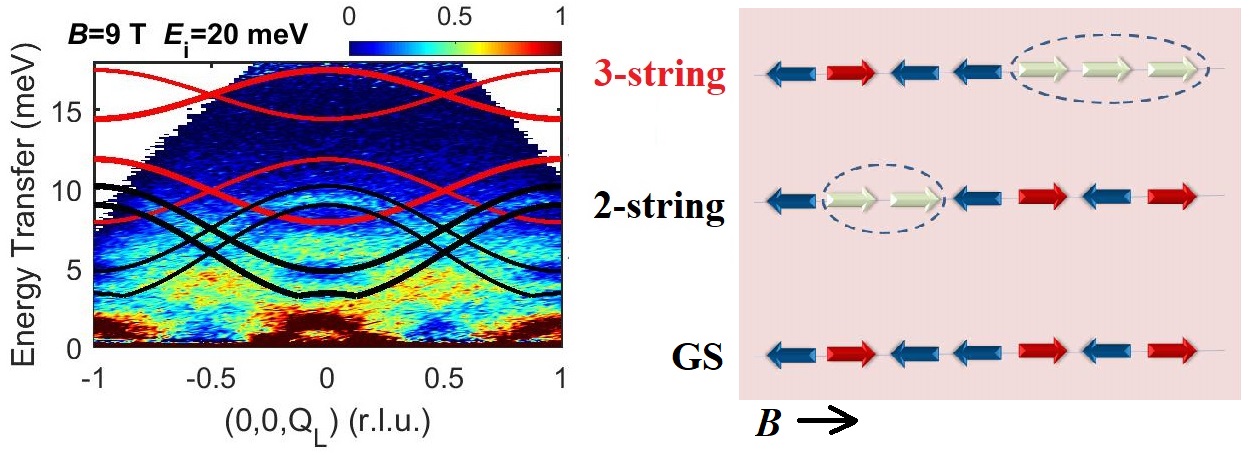Using neutron scattering experiments including LET at ISIS, and the high-field magnet of BER II at HZB, the group were able to collect experimental data that are in excellent agreement with the theoretical prediction of Bethe, illustrating how quantum physics can give accurate predictions of physical properties.
Complex interactions, including magnetic interactions, between atoms that are arranged within a lattice of a crystal can lead to new states of matter. Some crystals are magnetically one-dimensional, only having magnetic interactions in one direction. If a crystal of this type has successive magnetic moments pointing in opposite directions, this becomes a one-dimensional antiferromagnet. The existence of such a system was first described in 1931 by Hans Bethe, who also predicted the excitations of strings of two or more consecutive moments pointing in the same direction, so called Bethe strings.
These string states had previously not been observed under normal experimental conditions because they are unstable, and can be obscured by the other features of the system. Theoretical studies of quantum physics in one-dimensional systems are well established, because a one-dimensional theoretical model can be more straightforward than higher-dimensional ones, although harder to create in a real-world solid-state material.
Previous theoretical studies have shown that, in some one-dimensional models, the Bethe strings are hardly detectable by, for example, a spectroscopic method, because their contribution to quantum dynamics is negligibly small. In 2018, the group found the first evidence of Bethe strings in a chain antiferromagnet, SrCo2V2O8, by high-resolution terahertz optical spectroscopy in applied external high magnetic fields. In this system, only the cobalt atoms have magnetic moments, and they all are aligned parallel or antiparallel to a specific direction with adjacent moments cancelling each other out.
“The external field plays a crucial role. The Bethe string only become distinguishable from the other excitations in the field-induced gapless phase of the chain antiferromagnet," said Dr Anup Kumar Bera from the Bhabha Atomic Research Centre, Mumbai, India ; “This particular phase was rarely explored before, because neither a solid-state antiferromagnetic chain material nor the required strong magnetic field is easy to obtain." However, information on the dispersion of the string states in momentum space cannot be provided by the optical spectroscopy. “We need inelastic neutron scattering spectroscopy, for example" added Dr Zhe Wang from the University of Cologne.
The international collaboration's latest study, published in Nature Physics, shows the first experimental identification and characterisation of Bethe strings in a real solid: crystals of SrCo2V2O8. Using inelastic neutron scattering, the team resolved the dispersion of Bethe strings for the first time. The successful measurements relied on high-quality single crystals and high magnetic fields at a neutron scattering facility.

Left: The
experimental inelastic neutron scattering spectrum of SrCo2V2O8 measured on the
LET spectrometer at ISIS facility, RAL, UK at 0.08 K under longitudinal
magnetic fields of B = 9 T using a fixed incident energy of Ei = 20 meV. The
theoretical dispersion boundaries of the two-string and three-string
excitations are shown by the black and red curves.
Right: A snapshot of the
ground state (GS), as well as the two-string and three-string excitation states
(dashed ellipses).
"The LET spectrometer at ISIS has gained an excellent reputation for having clean signals and very low backgrounds" explains LET beamline scientist, Rob Bewley; “this is essential when studying very weakly scattering phenomena such as this 1D magnetic quantum system. Together with LET's very large 44 m2 detector array, and the ability to study samples at sub kelvin temperatures in large magnetic fields, made it a winning combination for this study."
From the neutron data gathered at BER II, the group obtained a phase diagram of the sample as a function of the magnetic field, and also further information about the internal magnetic patterns, which could be compared with the idea of Bethe that were quantified by a theoretical group led by Dr Jianda Wu from Tsung-Dao Lee Institute at Shanghai Jiao Tong University and Dr Wang Yang from the University of British Columbia in Vancouver. Their results enabled a detailed comparison to the experimental data, and the identification of the string-states dispersion. “Close collaboration between experimental and theoretical physicists is of particular importance for the achievements", said Jianda Wu; “In the long term, understanding these phenomena might lead to invention of new quantum technologies."
Professor Bella Lake from the Helmholtz Zentrum Berlin adds; “We were able to clearly identify two and even three chains of Bethe strings and determine their energy dependence. These results show us once again how fantastically well quantum physics works."
Further information
The full paper can be found online at DOI: 10.1038/s41567-020-0835-7
